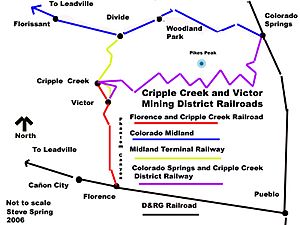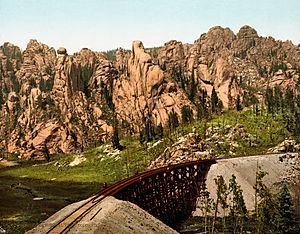Colorado Springs and Cripple Creek District Railway facts for kids
 |
|
| Overview | |
|---|---|
| Locale | Colorado |
| Dates of operation | 1897–1920 |
| Technical | |
| Track gauge | 4 ft 8 1⁄2 in (1,435 mm) standard gauge |
The Colorado Springs and Cripple Creek District Railway was a standard-gauge railroad. It operated in Colorado, USA, around the early 1900s. People often called it the "Short Line." This railway helped connect the busy gold mining areas near Cripple Creek with Colorado Springs.
Contents
History of the Short Line Railway
The Gold Rush and Early Railways
The Cripple Creek District Railway Company started on April 13, 1897. Its goal was to build a standard-gauge railway about 6.25 miles (10 km) long. This line would run between Cripple Creek and Victor, Colorado.
A big "Pikes Peak gold rush" happened in 1859. Many people hoped to find gold near Pikes Peak. But most didn't find anything valuable. The area got a bad name for gold. Then, in 1890, Bob Womack found rocks that actually had gold! This led to the creation of the Cripple Creek Mining District on April 5, 1891.
Building Railways for Gold
The new mining district needed better ways to move things than just wagons. So, railroads were built. In 1894, a narrow-gauge line called the Florence and Cripple Creek Railroad was built. It cost $500,000 and was about 40 miles (64 km) long. It reached the district from the south.
Soon after, the standard-gauge Midland Terminal Railway was built. This line came from the north and was about 30 miles (48 km) long. It cost a lot to build, about $25,000 per mile. At first, these two railroads competed. But then they joined together, creating a monopoly. This meant they controlled all the railway transport.
Mine owners who had mills in Colorado City (near Colorado Springs) decided to build their own railway. This was the Colorado Springs and Cripple Creek Railroad, or the "Short Line." It traveled along the south side of Pikes Peak. This new railroad helped lower the prices for moving goods. This made it easier to produce more gold.
Busy Times and Competition
At its busiest, the Midland Terminal Railway ran ten trains every day. Some trains were fancy, with special cars and champagne dinners for overnight trips from Denver. Freight trains carried coal, wood, explosives, and other supplies. On the way back, they carried gold ore to mills near Colorado Springs.
The railway's name changed to Colorado Springs and Cripple Creek District Railway on November 17, 1899. An extension to Colorado Springs opened in April 1901. The Colorado and Southern Railway managed the railway from 1904 to 1911.
The End of the Line
The Colorado Springs and Cripple Creek District Railway started losing money. This was because of competition from the Florence and Cripple Creek Railway and the Midland Terminal Railway. In 1911, the Colorado and Southern Railway leased the Short Line to the Florence and Cripple Creek. Later, in 1915, this lease went to the Cripple Creek Central Railway. This company also controlled the Midland Terminal Railway.
By 1917, most train traffic in the area used the Midland Terminal Railway. In May 1918, a bridge called the Bear Creek Bridge was lost. This cut off all direct traffic from Colorado Springs. The railway went bankrupt in 1919 and stopped operating in 1920. The tracks were then sold for scrap metal.
From Railway to Road
A man named W.D. Corley bought the bankrupt railway for $370,000. He owned a coal mine and raised cattle in Colorado Springs. He renamed it the Corley Mountain Highway. Corley removed all the tracks and put up toll booths at both ends. He opened the Corley Mountain Highway in 1926.
This amazing mountain road became very popular with tourists. Corley made about $400 a day by charging $1 per car. He operated his toll road with a special permit. When his permit ended in 1939, the road was given to the federal government. That year, the government changed its name to the Gold Camp Road.
Colorado Springs and Cripple Creek District Railway--Corley Mountain Highway
|
Colorado Springs and Cripple Creek District Railway--Corley Mountain Highway
|
|
| Lua error in Module:Location_map at line 420: attempt to index field 'wikibase' (a nil value). | |
| Nearest city | Colorado Springs, Colorado |
|---|---|
| Area | 115.6 acres (46.8 ha) |
| Built | 1900 |
| Architect | Colorado Springs & Cripple Creek RR; Corley, W.D. |
| NRHP reference No. | 99000400 |
| Added to NRHP | March 25, 1999 |
The Colorado Springs and Cripple Creek District Railway—Corley Mountain Highway is a historic district. It was added to the National Register of Historic Places in 1999. This is the same railway that was turned into the Corley Mountain Highway. After the US Forest Service took it over in 1939, it became known as Gold Camp Road.


